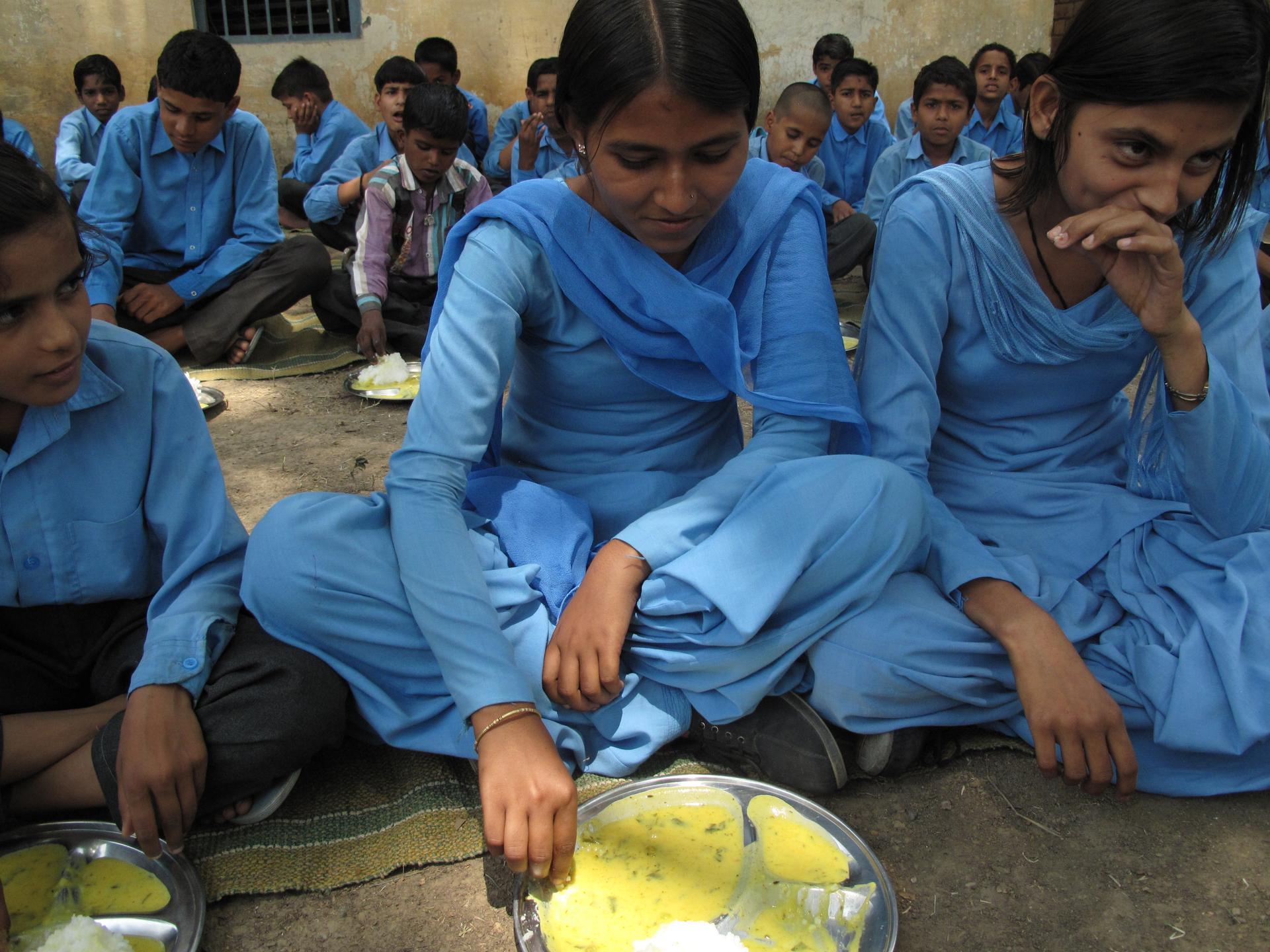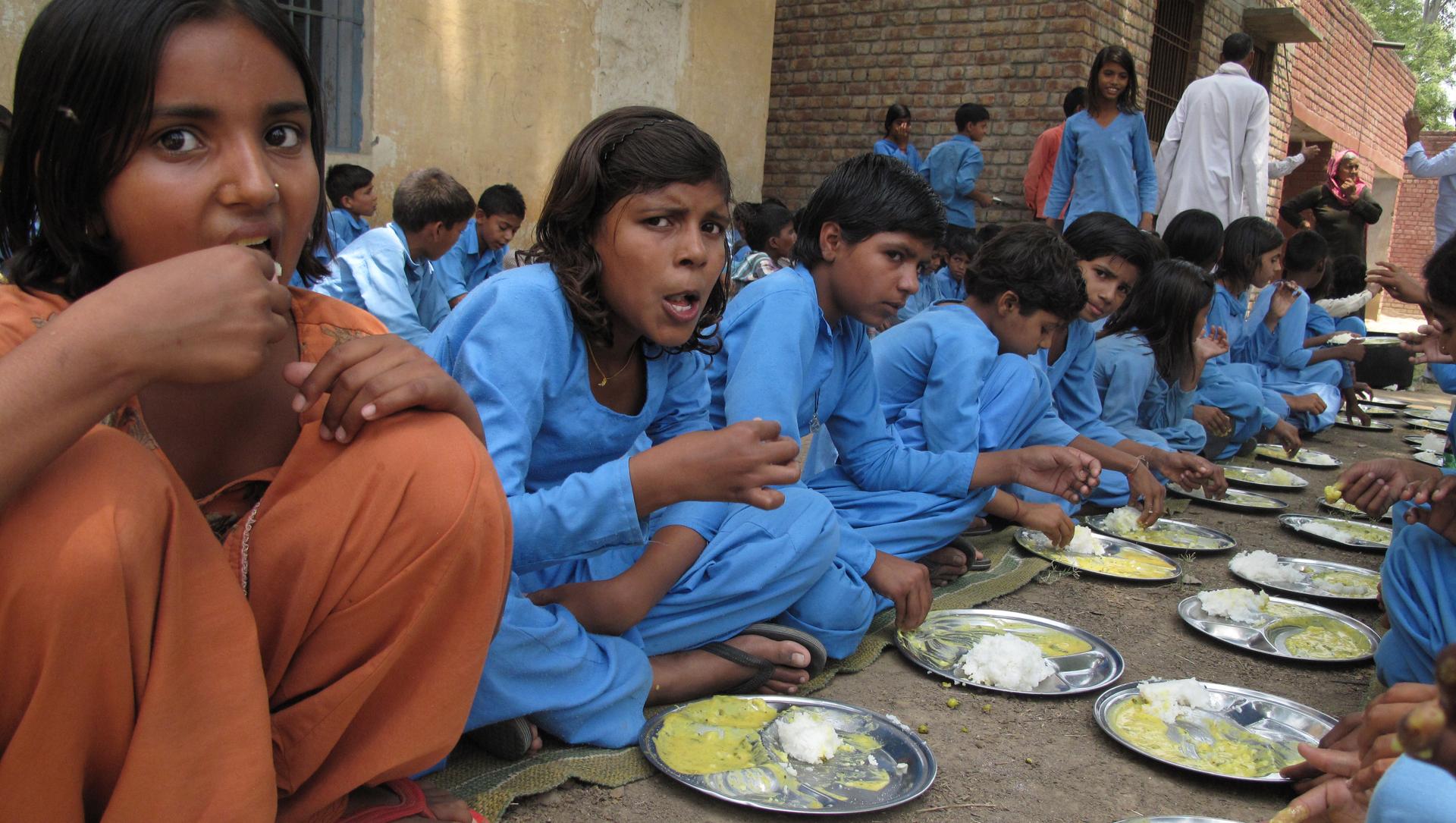India’s school lunch program not only fights hunger — it can breed tolerance
At a government school in Paposa, Haryana, children devour kadhi and rice.
India’s free school lunch program is one of the world’s largest anti-poverty programs. Despite its many shortfalls, the program feeds 120 million of the country’s poorest school children.
And since its launch in 1995, it has also helped boost the number of children enrolling in schools.
That’s been true in a village in Bawani Khera in the northern state of Haryana. On this day, students at the village school listen to teachers in their classrooms, while in another corner of the school, cooks are working inside a two-room kitchen. They’re preparing a curry made with sliced onion and garlic that they’ll serve with freshly cooked rice.
The vast majority of the children will sit next to each other on mats and eat the food, just as they do every day. That wasn’t the case, though, when India’s lunch program began at this school about a decade ago.
“Initially, some children refused to eat the food,” says Ram Niwas Jangra, who has taught at the school for 14 years.
Those children belonged to higher castes, while the cooks came from lower castes — mostly Dalits, the group once known as Untouchables.
When the school asked why the children were refusing the food, Jangra says the children told them that the cooks were unclean.
This idea of people belonging to lower castes being somehow dirty has its roots in the Hindu caste system. Traditionally, people in the lower castes did jobs considered unclean, such as tanning leather or cleaning people’s homes, even removing sewage.
For centuries, those from higher castes have refused to share food or drink with — or even touch — people from lower castes. Affirmative action and education have reduced discrimination in recent decades, but caste-based prejudices still exist, especially in rural areas.
The children who initially rejected the school food eventually relented, but only after the teachers convinced them that cleanliness was a priority for the school meals.
“We had to present our cooks as role models,” Jangra says. “We had to show them that they come to work clean and wash their hands before cooking.”
Shakuntala, who’s been cooking at this school for the past four years, belongs to a caste called Valimiki, considered one of the lowest in the caste hierarchy. She has never faced any problems at this school, she says, but she recalls a time not too long ago when discrimination was rampant in the village itself.
“When we went to work on a farm,” she says, “they served us water in separate pitchers and gave us food on separate plates.”
But now, she says, things have changed. Her neighbors belong to the Jat community (a higher caste and the predominant one in Haryana). But she says the two families often eat together.
Education has changed things, says Shakuntala. People were illiterate before; now they’re literate.
The school lunch program has also made a difference, she says. Most of the cooks are from lower castes, but no one objects to them cooking or serving the children, she adds.
When the school bell rings and children gather to get their free lunch, I watch them sit and eat together.
 Among the students here are two girls, sitting next to each other. They eat out of the same plate, as they chat and giggle through mouthfuls of food.
Among the students here are two girls, sitting next to each other. They eat out of the same plate, as they chat and giggle through mouthfuls of food.
They’re best friends, these two 12-year-olds.
The girl named Sumit is the daughter of the cook, Shakuntala. Her friend, Mohit, who’s taller and fairer, is a Jat. They’re from different castes, but the girls tell me they eat off of the same plate every day.
There are no systematic studies to prove this, and yet, most economists and food rights activists I spoke with say this is one of the program’s intangible and unexpected benefits.
“It’s kind of a socializing experience for children where they learn to sit together and eat regardless of class and caste,” says Jean Dreze, an economist at Ranchi University in the eastern state of Jharkhand.
Now, this doesn’t mean people no longer discriminate against lower castes.
A random scan of newspapers reveals that caste-based discrimination is widespread in some parts of the country, especially in this state of Haryana, which often makes headlines because of caste-based violence.
But the midday meal helps move things a little further in the right direction.
“This is very important in a country as unequal as India, where there is a long historical legacy of all kinds of inequalities,” says Dreze.
The idea is that if children of different castes can be taught to sit and eat together on a daily basis, it makes caste a little less important in their lives.
Rhitu Chatterjee’s Mid-Day Meal reports were produced with help from the Pulitzer Center on Crisis Reporting.
India’s free school lunch program is one of the world’s largest anti-poverty programs. Despite its many shortfalls, the program feeds 120 million of the country’s poorest school children.
And since its launch in 1995, it has also helped boost the number of children enrolling in schools.
That’s been true in a village in Bawani Khera in the northern state of Haryana. On this day, students at the village school listen to teachers in their classrooms, while in another corner of the school, cooks are working inside a two-room kitchen. They’re preparing a curry made with sliced onion and garlic that they’ll serve with freshly cooked rice.
The vast majority of the children will sit next to each other on mats and eat the food, just as they do every day. That wasn’t the case, though, when India’s lunch program began at this school about a decade ago.
“Initially, some children refused to eat the food,” says Ram Niwas Jangra, who has taught at the school for 14 years.
Those children belonged to higher castes, while the cooks came from lower castes — mostly Dalits, the group once known as Untouchables.
When the school asked why the children were refusing the food, Jangra says the children told them that the cooks were unclean.
This idea of people belonging to lower castes being somehow dirty has its roots in the Hindu caste system. Traditionally, people in the lower castes did jobs considered unclean, such as tanning leather or cleaning people’s homes, even removing sewage.
For centuries, those from higher castes have refused to share food or drink with — or even touch — people from lower castes. Affirmative action and education have reduced discrimination in recent decades, but caste-based prejudices still exist, especially in rural areas.
The children who initially rejected the school food eventually relented, but only after the teachers convinced them that cleanliness was a priority for the school meals.
“We had to present our cooks as role models,” Jangra says. “We had to show them that they come to work clean and wash their hands before cooking.”
Shakuntala, who’s been cooking at this school for the past four years, belongs to a caste called Valimiki, considered one of the lowest in the caste hierarchy. She has never faced any problems at this school, she says, but she recalls a time not too long ago when discrimination was rampant in the village itself.
“When we went to work on a farm,” she says, “they served us water in separate pitchers and gave us food on separate plates.”
But now, she says, things have changed. Her neighbors belong to the Jat community (a higher caste and the predominant one in Haryana). But she says the two families often eat together.
Education has changed things, says Shakuntala. People were illiterate before; now they’re literate.
The school lunch program has also made a difference, she says. Most of the cooks are from lower castes, but no one objects to them cooking or serving the children, she adds.
When the school bell rings and children gather to get their free lunch, I watch them sit and eat together.
 Among the students here are two girls, sitting next to each other. They eat out of the same plate, as they chat and giggle through mouthfuls of food.
Among the students here are two girls, sitting next to each other. They eat out of the same plate, as they chat and giggle through mouthfuls of food.
They’re best friends, these two 12-year-olds.
The girl named Sumit is the daughter of the cook, Shakuntala. Her friend, Mohit, who’s taller and fairer, is a Jat. They’re from different castes, but the girls tell me they eat off of the same plate every day.
There are no systematic studies to prove this, and yet, most economists and food rights activists I spoke with say this is one of the program’s intangible and unexpected benefits.
“It’s kind of a socializing experience for children where they learn to sit together and eat regardless of class and caste,” says Jean Dreze, an economist at Ranchi University in the eastern state of Jharkhand.
Now, this doesn’t mean people no longer discriminate against lower castes.
A random scan of newspapers reveals that caste-based discrimination is widespread in some parts of the country, especially in this state of Haryana, which often makes headlines because of caste-based violence.
But the midday meal helps move things a little further in the right direction.
“This is very important in a country as unequal as India, where there is a long historical legacy of all kinds of inequalities,” says Dreze.
The idea is that if children of different castes can be taught to sit and eat together on a daily basis, it makes caste a little less important in their lives.
Rhitu Chatterjee’s Mid-Day Meal reports were produced with help from the Pulitzer Center on Crisis Reporting.
